Galena Train Derailment
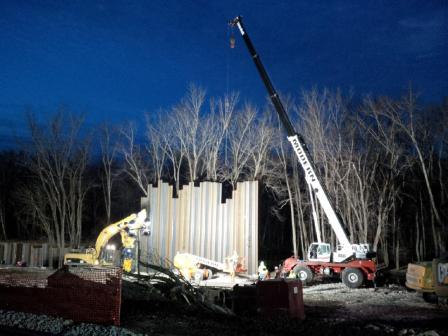 Contractors worked around the clock to install a sheet pile barrier to keep rising river water away from the affected area and oil away from the river.March 20, 2015:
Contractors worked around the clock to install a sheet pile barrier to keep rising river water away from the affected area and oil away from the river.March 20, 2015:
The U.S. Environmental Protection Agency response to the March 5 BNSF oil train derailment is complete. Illinois EPA will oversee the ongoing cleanup.
- U.S. EPA sampling of the surface water has not detected any oil in the Mississippi or Galena Rivers.
- All damaged tanker cars have been cleaned, cut up and removed from the site.
- U.S. EPA oversaw the construction of a sheet pile barrier that will keep rising Mississippi River water away from oil-contaminated wetlands and keep oil from reaching the river.
- U.S. EPA has approved BNSF's plans for assessing soil at the spill location, which is necessary to develop an environmental remediation plan. The next steps will be to excavate and remove contaminated soil from the site.
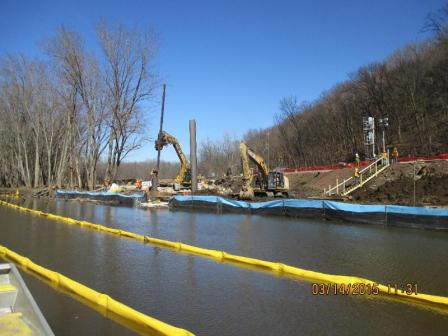 Workers install sheet pile along the Galena River to protect the area from rising water levels.March 17, 2015: The U.S. Environmental Protection Agency response to the March 5 BNSF oil train derailment continues.
Workers install sheet pile along the Galena River to protect the area from rising water levels.March 17, 2015: The U.S. Environmental Protection Agency response to the March 5 BNSF oil train derailment continues.
- U.S. EPA air monitors are detecting no elevated levels of airborne particles or other chemicals. U.S. EPA sampling of the surface water has not detected any oil in the Mississippi or Galena Rivers.
- All damaged tanker cars have been cleaned, cut up and removed from the site.
- U.S. EPA is overseeing the construction of a sheet pile barrier that will keep rising Mississippi River water away from the wetlands. Once the sheet pile wall is installed, U.S. EPA’s work at the site will be complete and Illinois EPA will oversee the ongoing cleanup.
- U.S. EPA has approved BNSF's plans for assessing soil and groundwater at the spill location, which is necessary to develop an environmental remediation plan. The next steps will be to excavate and remove contaminated soil from the site.
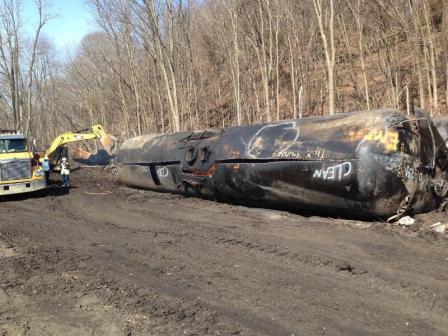 Workers cut apart one of the damaged tanker cars so it can be removed from the derailment site. (02-13-2015)March 14, 2015: The U.S. Environmental Protection Agency response to the March 5 BNSF oil train derailment continues. Efforts are currently underway to clean up the spill on seasonal wetlands next to the railroad tracks, to prevent oil from discharging into the Mississippi River due to seasonal rising water and to protect the adjacent wildlife refuge. U.S. EPA is overseeing construction of a sheet-piling barrier that will keep rising water away from the wetlands and an interceptor trench to collect and treat any water that may come into contact with crude oil at the site. U.S. EPA has approved BNSF's plans for assessing soil and groundwater at the spill location, which is a required step before developing an environmental remediation plan.
Workers cut apart one of the damaged tanker cars so it can be removed from the derailment site. (02-13-2015)March 14, 2015: The U.S. Environmental Protection Agency response to the March 5 BNSF oil train derailment continues. Efforts are currently underway to clean up the spill on seasonal wetlands next to the railroad tracks, to prevent oil from discharging into the Mississippi River due to seasonal rising water and to protect the adjacent wildlife refuge. U.S. EPA is overseeing construction of a sheet-piling barrier that will keep rising water away from the wetlands and an interceptor trench to collect and treat any water that may come into contact with crude oil at the site. U.S. EPA has approved BNSF's plans for assessing soil and groundwater at the spill location, which is a required step before developing an environmental remediation plan.
On March 5, 21 cars from the BNSF oil train derailed. Seven tanker cars ruptured and 5 of the ruptured cars caught fire. The last fire was put out on the morning of March 8. Roughly 218,000 gallons of crude oil has been recovered from the ruptured tanker cars.
EPA air monitors are detecting no elevated levels of airborne particles or other chemicals. EPA sampling of the surface water has not detected any oil in the Mississippi or Galena Rivers.
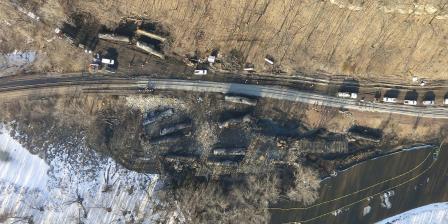 Aerial view of the oil train derailment site. (3-10-2015)March 11, 2015: The U.S. Environmental Protection Agency response to the March 5 BNSF oil train derailment continues. U.S. EPA personnel are onsite overseeing response and environmental sampling and monitoring activities. U.S. EPA representatives are serving in the roles of Incident Commander and Operations Chief in the Unified Command that includes Jo Daviess County, Illinois EPA and BNSF Railway. Highlights of today’s activities include:
Aerial view of the oil train derailment site. (3-10-2015)March 11, 2015: The U.S. Environmental Protection Agency response to the March 5 BNSF oil train derailment continues. U.S. EPA personnel are onsite overseeing response and environmental sampling and monitoring activities. U.S. EPA representatives are serving in the roles of Incident Commander and Operations Chief in the Unified Command that includes Jo Daviess County, Illinois EPA and BNSF Railway. Highlights of today’s activities include:
- To date, about 140,000 gallons of oil have been removed from the site.
-
Approximately one dozen rail cars remain on site. A few of the cars still contain oil. Work continues to remove oil from the remaining derailed tanker cars so that they can be removed from the site.
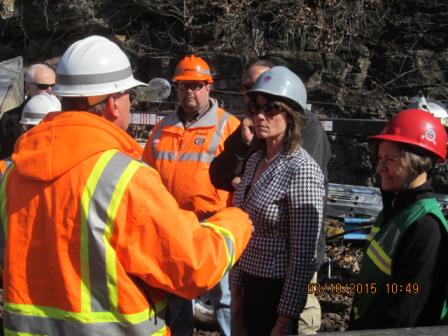 Rep. Cheri Bustos and U.S. EPA Regional Administrator Susan Hedman are briefed on cleanup progress at the site of the derailed oil train. (03-09-2015)March 9, 2015: The U.S. Environmental Protection Agency response to the March 5 BNSF oil train derailment continues. U.S. EPA personnel are onsite overseeing response and environmental sampling and monitoring activities. U.S. EPA representatives are serving in the roles of Incident Commander and Operations Chief in the Unified Command that includes Jo Daviess County, Illinois EPA and BNSF Railway. Highlights of today’s activities include:
Rep. Cheri Bustos and U.S. EPA Regional Administrator Susan Hedman are briefed on cleanup progress at the site of the derailed oil train. (03-09-2015)March 9, 2015: The U.S. Environmental Protection Agency response to the March 5 BNSF oil train derailment continues. U.S. EPA personnel are onsite overseeing response and environmental sampling and monitoring activities. U.S. EPA representatives are serving in the roles of Incident Commander and Operations Chief in the Unified Command that includes Jo Daviess County, Illinois EPA and BNSF Railway. Highlights of today’s activities include:
- Trains resumed running on the BNSF tracks this morning. The fires have been extinguished and damaged cars have been moved to the side of the railroad right of way. Some of the cars contain residual crude oil.
- Results of water sampling show no oil constituents.
- Crude oil that pooled in the area where the derailment occurred is being removed by vacuum truck.
- Samples have been taken of soil in the area where oil spilled from damaged rail cars.
- Air monitoring continues near the spill site and in the community.
- U.S. Representative Cheri Bustos, U.S. EPA Regional Administrator Susan Hedman, Illinois Emergency Management Agency Director James K. Joseph, and Illinois EPA Emergency Operations Unit Manager Blaine Kinsley toured the site of the derailment and cleanup.
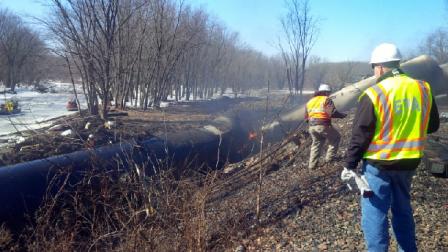 EPA on-scene coordinators inspect the site of the oil train derailment near Galena, Ill. (03-08-2015)March 8, 2015: The U.S. Environmental Protection Agency response to the March 5 BNSF oil train derailment continues. U.S. EPA personnel are onsite overseeing response and environmental sampling and monitoring activities. U.S. EPA has established a unified command which includes Jo Daviess County, Illinois EPA and BNSF Railway. At U.S. EPA’s request, the U.S. Coast Guard Atlantic Strike Team has deployed four safety officers to assist at the incident.
EPA on-scene coordinators inspect the site of the oil train derailment near Galena, Ill. (03-08-2015)March 8, 2015: The U.S. Environmental Protection Agency response to the March 5 BNSF oil train derailment continues. U.S. EPA personnel are onsite overseeing response and environmental sampling and monitoring activities. U.S. EPA has established a unified command which includes Jo Daviess County, Illinois EPA and BNSF Railway. At U.S. EPA’s request, the U.S. Coast Guard Atlantic Strike Team has deployed four safety officers to assist at the incident.
Highlights of today’s activities include:
- The last fire was put out this morning and the rail is cleared of cars and is being rebuilt. There have been no injuries or accidents among the public or responders. Trains are expected to be running on the tracks where the derailment occurred starting on March 9.
- U.S. EPA is continuing to take water samples in both the Galena River and Harris Slough of the Mississippi River. To date, no oil has been observed in either river.
- U.S. EPA is continuing to monitor air independently of BNSF contractors. Currently, no elevated levels of any pollutant are detected.
- U.S. EPA has directed BNSF to develop a soil screening and sampling plan for the cleanup and restoration of the affected soil on both sides of the track. This plan will be reviewed by U.S. EPA and Illinois EPA.
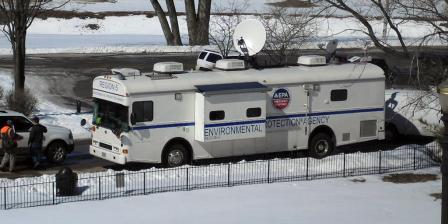 EPA is coordinating the response to the BNSF derailment from its mobile command post. (03-07-2015)March 7, 2015: The U.S. Environmental Protection Agency response to the March 5 BNSF train derailment continues. EPA personnel are onsite overseeing response and environmental sampling and monitoring activities. EPA has established a unified command consisting of all federal, state and local agencies (City of Galena departments) as well as BNSF Railway and its contractors.
EPA is coordinating the response to the BNSF derailment from its mobile command post. (03-07-2015)March 7, 2015: The U.S. Environmental Protection Agency response to the March 5 BNSF train derailment continues. EPA personnel are onsite overseeing response and environmental sampling and monitoring activities. EPA has established a unified command consisting of all federal, state and local agencies (City of Galena departments) as well as BNSF Railway and its contractors.
EPA is conducting air monitoring and will continue to do so until fires have been extinguished. Air monitors are no longer detecting airborne particles from the fire, and no oil has been observed in either the Galena or Mississippi Rivers. EPA will continue to inspect the shoreline daily. EPA is monitoring water quality in the Mississippi River and will begin soil and sediment sampling after emergency response activities related to the train wreck conclude.
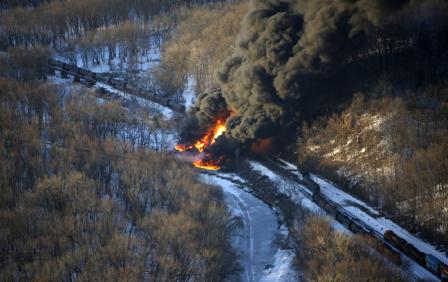 EPA is overseeing efforts to protect the nearby Galena River from leaking oil. (03-06-2015)March 6, 2015: The U.S. Environmental Protection Agency is responding to the derailment of a BNSF freight train that occurred near Galena, Illinois on March 5th. EPA is conducting air monitoring, taking water samples, assessing environmental damage and setting up booms to protect nearby waterways from oil leaking from the rail cars. So far, air monitors have detected airborne particles typically associated with fires but no chemicals.
EPA is overseeing efforts to protect the nearby Galena River from leaking oil. (03-06-2015)March 6, 2015: The U.S. Environmental Protection Agency is responding to the derailment of a BNSF freight train that occurred near Galena, Illinois on March 5th. EPA is conducting air monitoring, taking water samples, assessing environmental damage and setting up booms to protect nearby waterways from oil leaking from the rail cars. So far, air monitors have detected airborne particles typically associated with fires but no chemicals.
EPA has established a command post near the scene of the incident and is serving as the Federal On Scene Coordinator for federal agencies involved in the emergency response and coordinating work with state and local agencies.
Photo Gallery
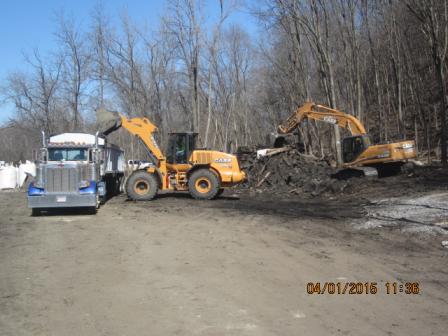 Loading out contaminated soil for transport to landfill facility. (4-1-15)
Loading out contaminated soil for transport to landfill facility. (4-1-15)
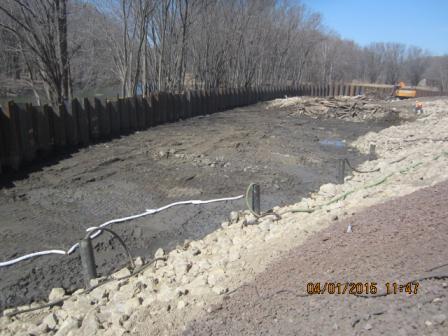 Excavation of soils from primary impacted area. A trench with sumps was installed along the railroad ballast to collect remaining product. (4-1-15)
Excavation of soils from primary impacted area. A trench with sumps was installed along the railroad ballast to collect remaining product. (4-1-15)
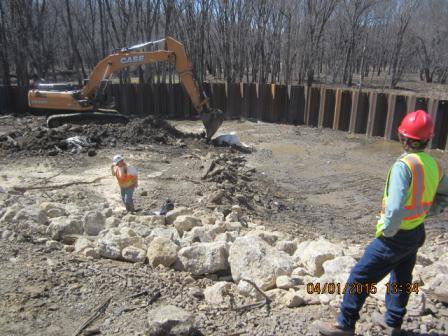 Illinois EPA Rockford Field Office personnel oversee excavation operations.
Illinois EPA Rockford Field Office personnel oversee excavation operations.
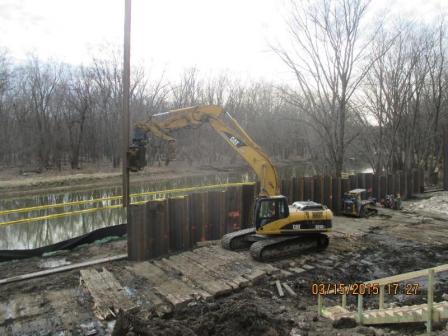 A sheet pile barrier has been installed around the affected area.
A sheet pile barrier has been installed around the affected area.
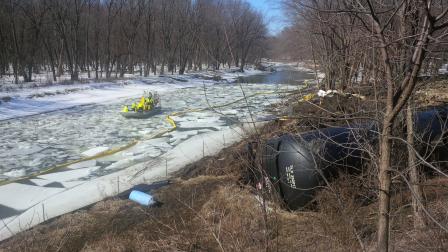 EPA on-scene-coordinators inspect the shoreline near the Mississippi River for oil. (03-09-2015)
EPA on-scene-coordinators inspect the shoreline near the Mississippi River for oil. (03-09-2015)
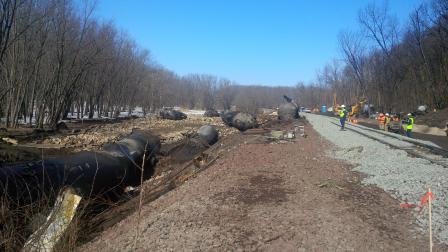 EPA will oversee cleanup of oil soaked soil around the damaged rail cars. (03-09-2015)
EPA will oversee cleanup of oil soaked soil around the damaged rail cars. (03-09-2015)
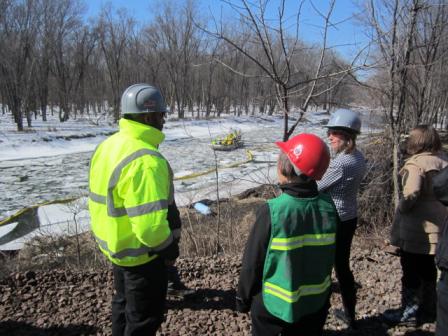 Rep. Cheri Bustos and U.S. EPA Regional Administrator Susan Hedman view the shoreline near the site of the derailed oil train with U.S. EPA incident commander Jaime Brown. (03-09-2015)
Rep. Cheri Bustos and U.S. EPA Regional Administrator Susan Hedman view the shoreline near the site of the derailed oil train with U.S. EPA incident commander Jaime Brown. (03-09-2015)
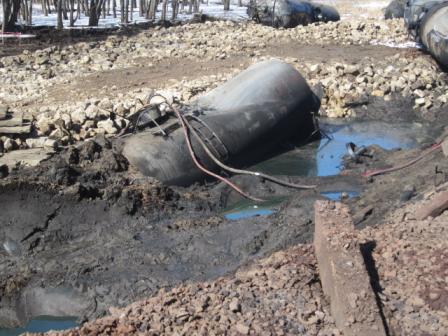 Pools of accumulated crude oil around one of the derailed tank cars. (03-09-2015)
Pools of accumulated crude oil around one of the derailed tank cars. (03-09-2015)
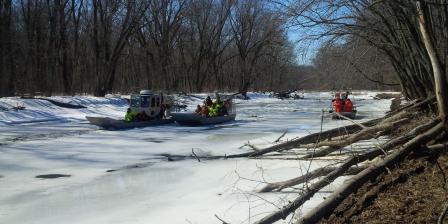 EPA on-scene coordinators use air boats on the frozen Galena River near the oil train derailment. (03-08-2015)
EPA on-scene coordinators use air boats on the frozen Galena River near the oil train derailment. (03-08-2015)
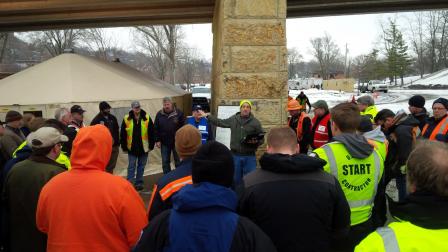 EPA on-scene coordinator briefs responders at the Galena oil train derailment. (03-08-2015)
EPA on-scene coordinator briefs responders at the Galena oil train derailment. (03-08-2015)
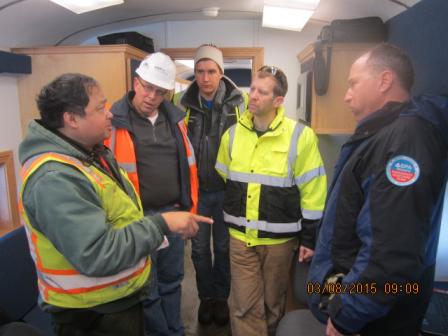 EPA on-scene coordinators are overseeing the response and environmental sampling and monitoring activities. (03-07-2015)
EPA on-scene coordinators are overseeing the response and environmental sampling and monitoring activities. (03-07-2015)
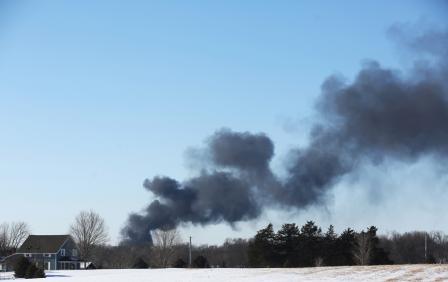 To protect public health, EPA is monitoring air quality near the burning rail cars. (03-06-2015)
To protect public health, EPA is monitoring air quality near the burning rail cars. (03-06-2015)
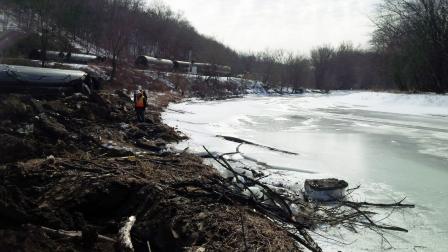 EPA has taken samples from the Galena River next to the crude oil freight train derailment. (03-06-2015)
EPA has taken samples from the Galena River next to the crude oil freight train derailment. (03-06-2015)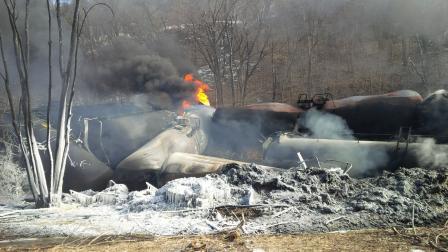 EPA monitors near the burning rail cars have detected airborne particles typically associated with fires, but no chemicals. (03-06-2015)
EPA monitors near the burning rail cars have detected airborne particles typically associated with fires, but no chemicals. (03-06-2015)
